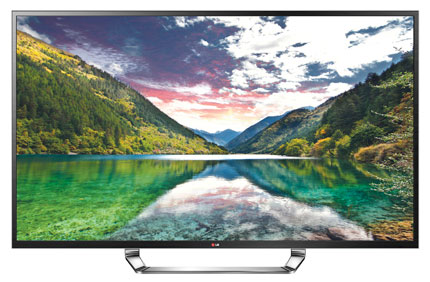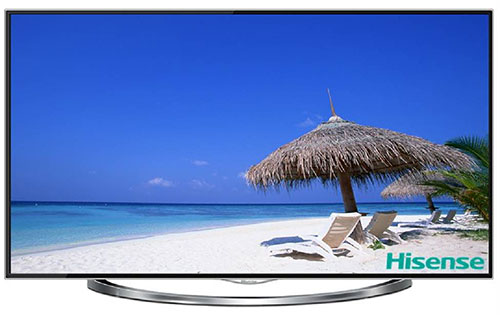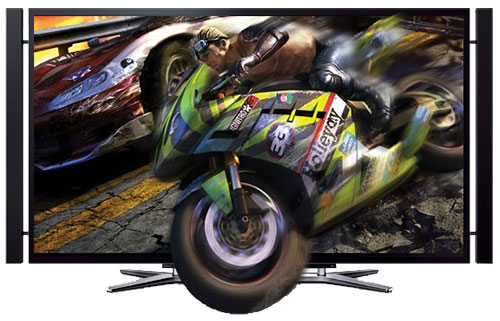
|
|
 |

|


 What in the HD World? What in the HD World?Ultra HD and OLED TVs Progress Report
Dick De JongNovember 15, 2012 HDTV Solutions Since I recently wrote about the emergence of 4K TVs and their Ultra HD rebranding, more TV manufacturers are throwing their hats into the ring. On a related issue, it's time to update the continuing saga of OLED TVs. On the 4K TV front, as expected Samsung is entering the fray with a mine-is-larger-than-yours 85" Ultra HD TV. (The previously announced LG and Sony models are 84".) The yet-to-be-released Samsung has just garnered a 2013 CES Best of Innovation Award that will be presented at the CES convention in January.  The $20,000 84" Ultra HD LG 84LM9600 Currently, details are limited about this mega-Ultra HD TV except for what is stated in the press release, "Samsung's UHD TV uses an innovative enhanced dimming technology and a very high contrast ratio to deliver deep, real blacks and pure whites for greater detail and unmatched picture clarity. This new, cutting-edge TV also offers a powerful and dynamic range of sounds." Samsung is waiting until the CES convention to reveal more. There's no indication of how much this 85" behemoth will cost, but I would imagine that it will fall into the $20,000 price range of the LG and Sony models. As I mentioned previously, I reckoned that we would see Ultra HD TVs with smaller screen sizes and proportional prices and indeed that prediction is bearing fruit. This week, Hisense announced that it also is a CES Innovations 2013 Design and Engineering Awards Honoree for its Ultra High Definition (4K UHDTV, 2160p) 65-inch TV, the 65XT880. If you are not familiar with Hisense, they are a Chinese appliance manufacturer who exports products to 130 countries. From my recent exchanges with their PR representatives, it looks as if Hisense is expanding its presence in the U.S. market.  The Hisense XT880 Ultra HD TV Along with the 65" version of the XT880 Ultra HD line, Hisense will be offering 50" and 58" XT880 models. I will report back after I have viewed them at CES in January. Once again, Hisense has not disclosed how much these 4K TVs will cost. I have no confirmation on Vizio, but I would expect that company to become a player in the Ultra HD game. If they do, they might prove a disruptive influence in the marketplace. Again, they have made no 4K announcements. If and when they do, I'll let you know. Of course, the egg - or is it the chicken - in this Ultra HD scenario is the availability of 4K content. On that front, just today, 3net, the newly minted Sony/Discovery/IMAX joint venture, revealed an initial slate of original 3D and 4K TV series and specials, including "Space", the first series to be produced in what the company calls "TotalD" (native 3D 4K, 2D 4K, 3D 2K and both 3D/2D HD formats). And TVNewsCheck is reporting that "A panel at the Content and Communications World convention predict that within five or so years the TV industry will be equipped with the necessities - cameras, editing tools and graphics equipment, among them - to implement the use of 4K technologies." I've also read that satellite company, DirectTV is moving forward with its plans to offer 4K transmissions by 2016. Of course, a fast, reliable 4K distribution system is essential to viewing 4K content on our TVs. And if it isn't furnished by more conventional cable or satellite providers then maybe we will see a high speed data pipeline from an Internet company like Google, which is just rolling out their Google Fiber service in Kansas City. One of their first customers is reporting consistent Google Fiber speeds of 600 to 700 Mbps., which is 100 times faster than what is often considered quick with existing services. And I would hazard that data rate is more than sufficient to push 4K video smoothly to your Ultra HD TV. Therefore, the stars are beginning to align for a transition to 4K. No doubt there will be fits and starts along the way, but the move to HD from SD has made everyone familiar with the process, which will probably take five or ten years. A footnote about the Ultra HD brand, Sony has announced, "As leaders at the forefront of new display technology such as HD, 3D and beyond, we laud the CEA's efforts to come up with a common language to describe the next generation high-definition technology, however, to ensure clarity for consumers and delineate between today's and tomorrow's technology, Sony will continue to use the 4K moniker for its products and will market its future products as 4K ultra high-definition (4K UHD)."  The $25,000 84" 4K UHD Sony XBR-84X900 Call it what you will, 4K, Ultra HD, or UHD, the format is ascending the far horizon. As for OLED HDTVs, the rise into the marketplace has become slower than was expected last January at CES when both LG and Samsung were displaying their OLED prototypes. Representatives from both companies believed that we would see OLED models arriving mid-2012. Last week, market research firm, NPD DisplaySearch stated in their Quarterly Global TV Shipment and Forecast Report that, "OLED TV panel makers and set manufacturers are still targeting commercialization this year. The report disclosed that at least 500 OLED TVs will ship in 2012. While this is a very small quantity in comparison to the total TV market, the start of shipments will be an important breakthrough." Though in the near future it might seem that OLED TV and Ultra HD models are competing for the same high-end ground, remember that OLED is a display technology and Ultra HD is a resolution (3840 x 2160 pixels). If OLED manufacturers can solve their mass production difficulties, there is no reason why we won't be marveling at an OLED Ultra HD beauty some time this decade. We'll continue to monitor the progress of the OLED TV marketplace and see what news CES 2013 brings. Stay tuned.
|
Bookmark:
![]() del.icio.us
del.icio.us
![]() Reddit
Reddit
![]() Google
Google
| Send this Page | Print this Page | Report Errors |

